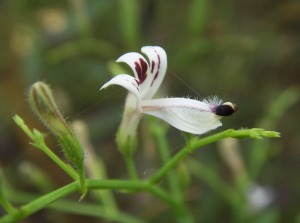
Botanical Name: Andrographis paniculata
Common name: Chiretta, King of Bitters, Kalmegh (Bengali, Hindi), Kirata (Sanskrit), chuan xin lian (Chinese) (Bone & Mills, 2013, p. 360).
Family: Acanthaceae (Bone & Mills, 2013, p. 361)
Parts used: Whole herb (including root) (Bone & Mills, 2013, p. 360)
Constituents
- Diterpenoid lactones (“andrographolides”): Algycones and Glucosides
- Diterpene dimmers
- Flavonoids
- Xanathones (root)
(Bone & Mills, 2013, p. 360)
Actions
- Bitter tonic
- Choleretic
- Immunostimulant
- Hepatoprotective
- Antipyretic
- Anti-inflammatory
- Antiplatelet
- Antioxidant
(Bone & Mills, 2013, p. 360).
History
Used medicinally in Ayurvedic medicine, Chinese medicine and throughout South-East Asia (Bone & Mills, 2013, p. 360).
In Chinese medicine the herb is considered bitter and cold (Bone & Mills, 2013, p. 360).
Traditional thereaputic use includes
- Loss of appetite
- Atonic dyspepsia
- Flatulence
- Diarrhoea
- Dysentery
- Gastroenteritis
- Bowel complaints in children
- Sluggish liver
- Diabetes
- General debility
- Convalescence after fevers
- Respiratory and skin infections
(Bone & Mills, 2013, p. 360)
Indications (contemporary)
- Bacterial and viral infections
- Common cold
- Acute sinusitis
- Pharyngotonsillitis
- Enteric evidence
- Prevention of urinary tract infections
- Prophylaxis of common cold
- Familial Mediterranean fever
- Ulcerative colitis
(Bone & Mills, 2013, p. 360).
Preparation
- Decoction (dried or fresh herb)
- Infusion
- Fluid extract
- Tablet or capsule
- Succus (leaf juice)
(Bone & Mills, 2013, p. 360)
Dosage
Preventative dose (adult): 2-3g or equivalent per day
During infection: 6g/day
(Bone & Mills, 2013, p. 360)
Cautions
High doses may cause gastric discomfort, loss of appetite and vomiting (Bone & Mills, 2013, p. 370)
Contradictions:
- Pregnancy, notably early pregnancy (Bone & Mills, 2013, p. 369)
- States of hyperacidity (i.e. duodenal ulcers or gastrointestinal reflux) (Bone & Mills, 2013, p. 369).
Combinations
As Andrographis is considered “cold”, is it traditionally combined with warming herbs such as ginger, Astragalus and tulsi (Bone & Mills, 2013, p. 361).
REFERENCE
Bone, K., & Mills, S. (2013). Principals and Practice of Phytotherapy (2nd ed.). Edinborough: Churchill Livingstone/Elsevier.
Image: Imbert, P. (2011). Andrographis, Between tradition and modernity. Retrieved from: http://www.entretiens-internationaux.mc/andrographis-between-tradition-and-modernity-61.html